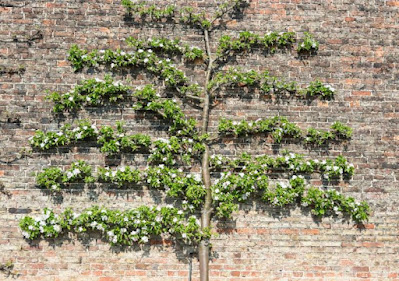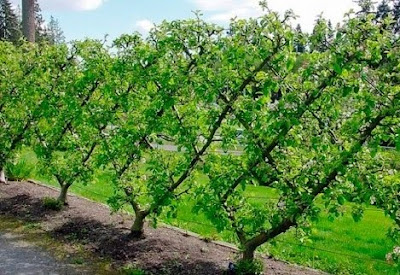Espalier is the ancient gardening technique that involves training a tree or shrub to grow flat, usually against a wall or trellis. Espaliers are commonly used in small gardens, courtyards, and even on balconies and are a great way to provide fruit in limited spaces. During this post, we'll take a look at the history and benefits of espalier, how to take care of espalier, and end with an espalier polyculture.
At first glance, Espalier may appear to be some kind of plant torture but this is not the case. House plants slowly thirsting and starving to death in a dimly lit corner of a room, that's torture. Planting a garden in spring and then disappearing for the summer leaving the plants stranded in the hot sun, their cells dehydrating one by one, that's torture. You know when we continually adjust the position of our house plants when they lean over just when the plant has taken the time and effort to adjust its shoot system to capture all the light it needs. Along comes a symmetry-obsessed ape and spins it back to square one, that is plant torture. Espalier, on the contrary, is more like plant pampering.
The Origins of Espalier
Trees are typically trained up against walls, along wireframes or trellises, and can take a variety of forms
Some espaliers can be huge taking up entire walls on a property but a lot of the time espaliers are grown on small structures to be easy to reach and manage.
It's also possible to grow them freestanding without any support or structures. We are trying this with an apple tree on the drip line of a lwalnut.
As long as your espalier plants are well watered and fed and have enough light they will be fine.
Why Espalier?
- When you would like grow your own fruit but have limited space
- If you only require a little fruit at a time but would like a lot of fruit diversity throughout the year.
- For easy picking with no ladder or tools needed for harvest
- Espalier can be used to provide a beautiful and functional subdivision or boundary
- It's a great option if you would like to grow multi-layers of light-demanding plants or if you would like to integrate fruit trees into an existing garden but do not want to create lots of shade.
- In colder climates, when growing an espalier on a South facing wall or fence. The extra warmth provided by the wall's thermal mass makes it possible to grow fruit that would not be considered hardy or would not normally ripen.
- If you appreciate an intimate relationship between you and a plant and enjoy the art of pruning and training fruit trees to a desired shape, like big Bonsai.
What Plants to Choose?
Apple and pear are most commonly used for espalier with the spur-bearing cultivars producing the highest yields but you can use any fruit tree you wish. We have Sour Cherry- Prunus cerasus trained around a wall of an old adobe building in our backyard. We are not short of cherries at our place and a lot of the fruit produced from this tree is often left for the birds but it does serve as a good pollinator partner for the other Cherry trees in the garden. We are often removing vertical shoots and new growth that grow away from the stem and feeding them to the rabbits and pigs. Sour Cherry - Prunus cerasus being quite a vigorous grower can make quite a mulch machine when grown this way.
Whatever species of plant you choose, you should start with a “whip,” a 1m tall single-stemmed plant that has not yet grown any side branches, and the regular fruit tree selection criteria will apply
- Climatic compatibility with your site
- Select cultivars that are disease and pest resistant
- Suitable size for your site i.e select suitable rootstock
- Select plants that provide fruit when you require it
- Make sure you have pollination partners and if you are only growing one, make sure it's self-pollinating
Where to Grow
Growing against South facing walls offers climatic advantages absorbing heat and hastening fruit ripeness, however, the problem with South facing walls is that the ground below can dry very fast when hot and will require attentive irrigation while the plant is establishing. You need good soil as the plants you select are probably going to be there for many decades, ideally deep, free draining, friable, fertile soil with a nice thick layer of mulch on top.
Want to learn more about Regenerative Landscape Design? Join The Bloom Room!
The Bloom Room is designed to create a space for more in-depth learning, for sharing projects and ideas, for seeking advice and discovering opportunities.
Ultimately, it aims to build a more intimate, interactive, and actionable relationship between members, a way for the Bloom Room community to support each other’s projects and learning journeys, and to encourage and facilitate the design, build, and management of more regenerative landscapes across our planet.
What you can expect as a member of the Bloom Room
As a member of the Bloom Room you can expect;
Access to an interactive forum where you can ask questions, direct what type of content you would like to see as well as share your own content and projects.
Monthly live session featuring general Q&A and tutorials on design software for creating and presenting polycultures.
Full Access to all of the content on Substack
A 500 EUR discount on all of our online courses
Future opportunities to join our Global Regenerative Landscape Design and Consultancy Service, with potential roles for those with the will and skill to join our design team.
An opportunity to take part in the group ownership of a Regenerative Landscape. You will find more details on that here.
Become a paid subscriber to our Substack to join. The annual subscription is currently $70 and the monthly subscription is $7 (monthly subscription excludes discounts for products and services) . You can join here, we look forward to meeting you!
How and When to Prune
How to Build Espalier
You can find some very easy-to-follow instructions on youtube on how to set up your espalier frames whether that be out in the open or up against a wall. Basically, it involves building a frame and tying branches to it.
Regenerative Landscape Design - Online Interactive Course
Want to learn how to design, build and manage regenerative landscapes? Join us on our Regenerative Landscape Design - Online Interactive Course. We look forward to providing you with the confidence, inspiration, and opportunity to design, build and manage regenerative landscapes, gardens, and farms that produce food and other resources for humans while enhancing biodiversity.
You can access the course material at anytime and join the live sessions and interactive forums that run from May - Oct every year. All members of the Bloom Room receive a 500 EUR discount. To take up this offer all you have to do is become an annual subscribers to our Substack and register here with the promo code BLOOM. I look forward to you joining !
An Espalier Polyculture
Here's a polyculture design that we have not yet implemented. It's a perennial productive polyculture that features a row of espalier apples and provides a succession of salad, vegetables, and apples throughout the year. It's ideal for smaller gardens or when you donʼt want to climb for your apples. We'll be posting the full profile of this polyculture on this blog later in the year. You can find full profiles for a number of other polycultures here.
Support Our Project
If you appreciate the work we are doing you can show your support in several ways.
Become a member of the Bloom Room. A $70 annual or $7 per month subscription to our Substack provides you with access to live sessions, design tutorials, a members forum and more, see details here.
Make a purchase of plants or seeds from our Nursery or Online Store
Joining us for one of our Practical Courses or Online Courses
Comment, like, and share our content on social media.
If you appreciate the work we are doing you can show your support in several ways.
Become a member of the Bloom Room. A $70 annual or $7 per month subscription to our Substack provides you with access to live sessions, design tutorials, a members forum and more, see details here.
Make a purchase of plants or seeds from our Nursery or Online Store
Joining us for one of our Practical Courses or Online Courses
Comment, like, and share our content on social media.


.jpg)
.jpg)

.jpg)
.png)


.png)

.jpeg)






No comments:
Post a Comment